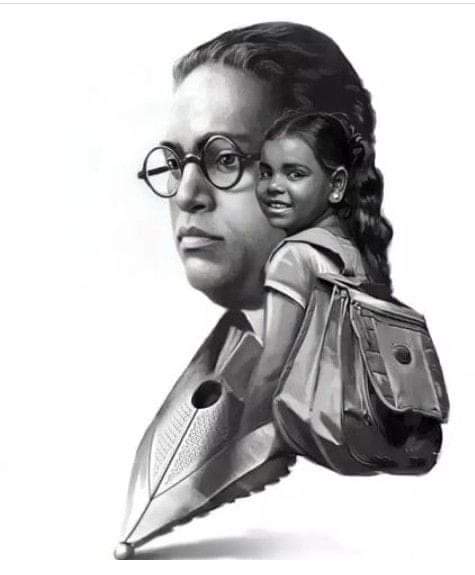By Mukhtar Khan
Dr. Babasaheb Ambedkar’s impact on the history of social revolution must not be disregarded. After obtaining a doctorate in economics from Britain, he arrived in India in 1917. He was appointed as the Minister of Finance in the princely state of Baroda under a contractual agreement, but his tenure was brief. Babasaheb Ambedkar faced degrading treatment from the court employees who considered him an untouchable, despite his impressive education and prominent position. The Legacy of Babasaheb Ambedkar
Babasaheb Ambedkar Returns Mumbai:
Babasaheb Ambedkar Returns to Mumbai, Leaves High-Prestige Job In the same year, Babasaheb Ambedkar returned to Mumbai and was soon appointed as a Professor of Political Economy at Sydenham College. Despite being one of the most educated individuals of his time, he faced multiple instances of caste-based discrimination. Babasaheb was acutely aware of the oppression Dalits faced in society, having experienced it firsthand. For centuries, Dalits had been socially boycotted, branded with the derogatory label of ‘untouchable,’ and denied basic rights, such as entering temples, walking on public roads, and drawing water from communal ponds and wells. The inhumane treatment of Dalits deeply troubled Babasaheb, but he remained resolute and chose to fight against this deep-rooted injustice. He sought to eradicate these social evils from society.
Oppression of Dalits during British rule:
At that time, the country was ruled by the British, and there had been no change in the Indian social system even during their regime. The struggle for freedom was being led by Mahatma Gandhi, and Baba Saheb used to emphasize that “Our freedom is incomplete without the liberation of the Dalit society.” To achieve the emancipation of Dalit society, Babasaheb Ambedkar chose the path of mass struggle and mass movement. He understood that through this struggle, they could not only obtain their rights but also awaken a sense of self-respect within the downtrodden section of society who had suffered for centuries.

Status of Dalit society in Maharashtra:
Even in Maharashtra, Dalits were denied access to public tanks or wells in many areas. If a Dalit person dared to take water from a public source, the entire community would suffer the repercussions. It is unfathomable that even basic resources such as water, land, and forests, which should be accessible to every individual, were being withheld from Dalits.
Choosing the path of struggle:
Baba Saheb belonged to the Dalit community and was well-versed in the Sanatani system of Indian society. Witnessing the plight of Dalits, he was deeply moved and hurt by their societal status as outcasts. As an educated individual, Babasaheb Ambedkar had two options for his future: to pursue wealth through his education or to fight for the emancipation of the helpless Dalits by becoming their voice. Babasaheb chose the latter and, in 1924, formed an organization in Mumbai called the ‘Bahishkrit Hitkarini Sabha’ for the upliftment of Dalits. This association included not only untouchable members but also progressive upper-caste members. Meetings were held under this association at various locations.
Chavdar Talao Movement:
In those days, a government ordinance was passed by the Mumbai Presidency that granted all citizens rights over public water sources such as ponds and wells. Acting on this law, Surendranath Tipnis, the mayor of Mahad, declared the Chaudar pond a public property in 1924, giving everyone the right to access its water. However, the upper castes continued to impose a social boycott on Dalits, prohibiting them from taking water from the pond. Even if a Dalit had the courage to attempt to access the water, they would face severe punishment. As a result, Dalit women were forced to walk long distances in search of water.
Invitation to visit Mahad:
The Municipal President of Mahad, Surendra Nath Tipnis, extended an invitation to Baba Saheb Ambedkar to come and dedicate the Chaudar pond to the public. Baba Saheb accepted the invitation and arrived in Mahad two months before the scheduled date in January 1924. His arrival sparked enthusiasm and hope among the local Dalits. Baba Saheb was already familiar with the region, as many people of the Mahar caste had settled in the area after serving in the British Army.
Baba Saheb recognized the disciplined nature of the Mahar community and sought their support for the Satyagraha. He established a dialogue with the locals and worked closely with R.K.B., a Dalit leader, to raise awareness about the rights of Dalits. Baba Saheb’s words had a profound impact on the people, and gradually thousands began to join the Chaudar Talab movement.

Baba Saheb vehemently argued that access to public resources, such as the Chaudar pond, was a fundamental right for all individuals, regardless of their caste or religion. He pointed out the injustice of denying Dalits access to water sources that even animals could drink from without objection. “Every man has the same rights,” he declared.
Under Baba Saheb’s leadership, the movement gained momentum, and the struggle for Dalit rights began to take shape in Mahad.
Support all classes:
While the Sanatani Hindus were opposing the Mahad movement, a significant section of society was supporting Baba Saheb and the Dalits. The support extended beyond the Dalit community, as seen in Kazi Hussain’s act of providing his land for the agitators to stay. Even individuals from the upper caste society such as Dr. Surendranath Tipnis, Gangadhar Neelkanth Sahastrabuddhe, Anant Vinayak Chitre, and Kayastha Prabhu came forward to help Dr. Ambedkar in his cause.
Mahad Satyagraha:
March 20, 1927, is the historic day when Baba Saheb Ambedkar did Satyagraha along with thousands of Dalits. The whole form of this movement was non-violent. Baba Saheb Ambedkar reached the Chowdar Pond (Chowdar means Sweet in Marathi) and drank the Tasty water of the pond with his hands. In this way, along with Baba Saheb, hundreds of Dalit communities also drank the sweet water of the pond and thus breaking the shackles of hundreds of years of slavery.
Significance of the ‘Chavdar Talao’ movement:
The Mahad movement, spearheaded by Babasaheb Ambedkar a century ago, was a turning point in the history of India. For the first time, Dalits fought for their rights through mass struggle and Satyagraha under the leadership of a Dalit leader. The significance of the movement was not just limited to the right to water, but also encompassed the broader issue of equal rights to all natural resources.
Dr. Ambedkar emphasized that every human being has equal rights to land, forest, mountain, tree, sun, and sky. The movement raised Dalit issues and prioritized them in Indian politics. The movement also led to a new consciousness within the Dalit community.

Even today, on March 20th, thousands of Dalits from across the country come to Mahad’s Chavdar Talab to commemorate the movement and chant slogans of “Jai Bhim.” The struggle of Chavdar Talab highlights that natural resources belong to all and everyone has an equal right to water, air, and sun.
However, in the current era, under the guise of development and law, natural resources are being taken away from common people through industries, mining, and markets. The significance of the Mahad movement remains relevant as it serves as a reminder of the common people’s rights to water, land, and forests.
The views expressed in this article are solely those of the author and do not necessarily reflect the opinions or views of this newspaper/Magazine. The Author can be reached at [email protected]
Leave a Reply